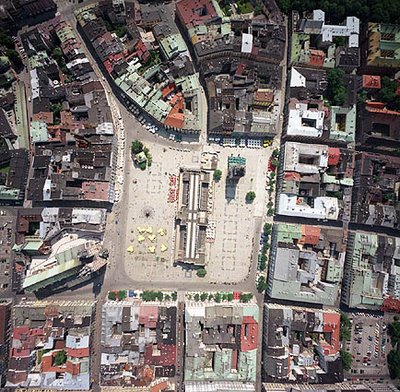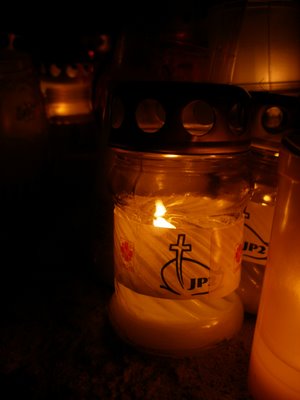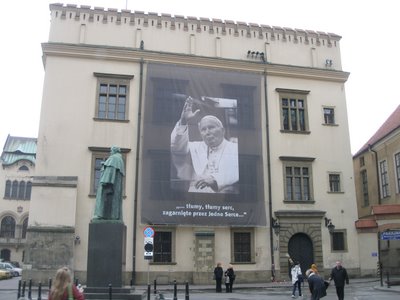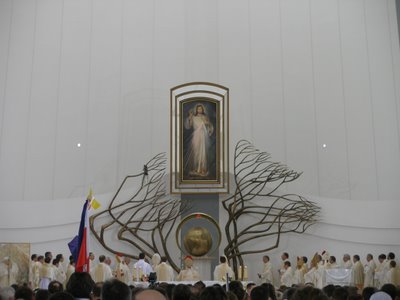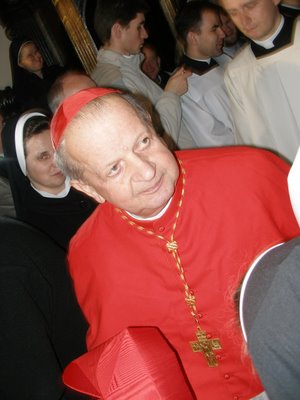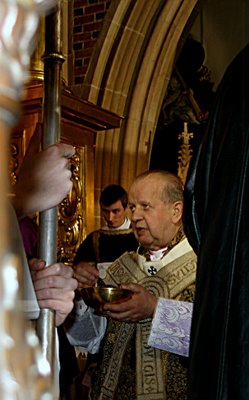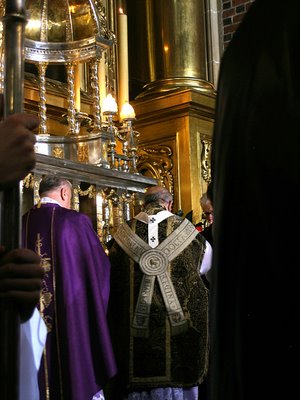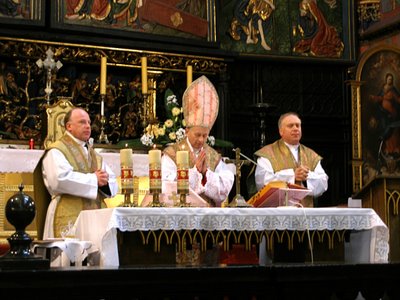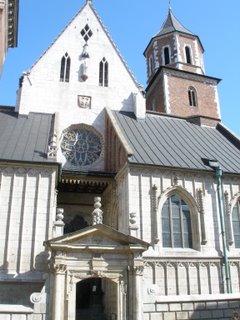The Law and Justice Party is headed by Lech Kaczynski as the president, even though many people claim that the real power lies in his twin brother, Jaroslaw, who is the head of the party. The party has taken upon itself to purge the government and all government institutions of former members of the PZPR, the Polish communist party, many of whom have high positions in the state-run media, and in the various branches of government. Naturally, a post-communist, liberal media has not been sympathetic to a conservative, anti-communist, pro-life, pro-marriage, Catholic president, whose Prime Minister wears a Rosary ring and is seen regularly at public Masses (I have been to four with him in the past few weeks). Perhaps they also fear that the purge is coming their way, with the passage of a new bill on media reform.
As in the United States, and in Western Europe, one of the major debates in Poland right now is the debate about the “persecution” of homosexuals. Three weeks ago, the Human Rights Watch, a New-York based group, declared that an official “homophobia” exists in Poland. Statements such as this, and extreme pressure from the pro-homosexual European Union, of course, only further encourage the Polish minority of homosexuals to “battle” with the Polish government, the Church, and with the traditionally Christian culture of this country. The most notorious “fighter” is Robert Biedron, the president of Poland’s Campaign Against Homophobia, who thinks that the Kaczynskis are “medieval conservatives.” Of course, he seems not to recall the fact that homosexuals would have been tortured or burned in the Middle Ages, while now they enjoy full rights as citizens, and nobody is harming them in any way. Kaczynski’s justification of banning a homosexual parade as president of Warsaw, when he stated, “sexual orientation is a private matter and should be kept as such,” has been perceived as, “homosexuals should be kept silent and denied their rights.” Either way, there is great pressure in small sectors of society to make Poland a place “safe for democracy,” a country of “tolerance,” because the Polish constitution gives equal rights to all people.
Tomorrow, the march of gays and lesbians, and their supporters, will begin at the Barbakan, the old gate to the city, and then proceed along the streets, ending on the market square. In an ironic and perverse reversal, the famous gate that led to the royal city and the capital of Catholic Poland, will now be the gathering place of anti-Catholic liberals and homosexuals. To make things even more exciting, at the same time, the city authorities have issued a permit to the “All-Polish Youth,” an ultraconservative group of young people, often misrepresented as fascists and homophobes, who will also be gathering tomorrow on the market square in support of traditional Polish values. While the group is not a fascist group, as they are widely called, the group is not exactly known for its “peaceful” demonstrations. It will be interesting to see what will happen when the two groups meet on the main market square. As one blogger, clearly fed up with the debate, wrote, “I hope all of those idiots from both sides beat each other up.”
On the one hand, I see the justification of such a comment, since the debate in Poland has been present in the media for a few years, with the Gazeta Wyborcza, a Polish paper similar in political outlook to the New York Times, publishing at least two or three articles daily about gays and their battle for rights in Poland. Nobody mentions the fact that, when in a country of forty million people, five hundred show up at a rally, it is a good turnout. I wonder how many will come tomorrow. From posters that hail “Krakow: City of Tolerance,” to newspaper announcements, the planned pro-gay “rights” protest has had a lot of media hype. Of course, there have also been posters calling for “STOP Deviations and Disorders.”
On the other hand, I think that the issue cannot be dismissed so cynically, and is very important to consider. This whole state of affairs reveals to us the workings of revolutionary groups, which seek to undermine established order. In his brilliant novels, and particularly in Demons, Dostoevsky’s characters give the reader much insight into the workings of revolutionary groups in Russia during the nineteenth century. Socialism, nihilism, rationalism, and other revolutionary philosophies were exported to Russia from the West, particularly France and Germany, and implanted into important and influential circles of the academic elites. Small groups of intellectuals gathered, having adopted these ideals, and planned to overthrow the existing social order by spreading the revolutionary ideals to the rabble, who would be responsible for carrying out the bloody changes.
Rather than seeking to dialogue with the established social order, and with the powerful Orthodox Church in Russia, the revolutionaries naturally saw religion and the traditions of their country as their number one enemy:
Firm the people stood,
For liberty, equality, brotherhood…
And when rebellion once was sparked…
To hold property as one,
And take their just revenge upon
Marriage, church, and family ties—
Evils in which the old world lies.
Here, Pyotr Stepanovich, in Demons, presents the plan of the revolutionaries. It seems that not much has changed in the modern culture war. In the name of “tolerance,” of “democracy,” and ultimately, in the name of “liberty, equality, and brotherhood,” the homosexual agenda is pushed. The Church, the family, and the marriage are all seen as “evils of the old world,” and are flatly rejected and undermined by radical activists. The people who actually struggle with homosexual tendencies, and feel the deep inner hurt and longing for love and fulfillment, have become victims of a few activists in a system which is proposed among the intellectual elites, based upon a faulty notion of “freedom” and human “rights.” This is evident in the invention of an entire discipline of studies to support their movements—studies in “gender” and in “queer theory.” These ideas are implanted into the ideas of young people, and then spur some, who may already have homosexual tendencies, on to live a homosexual lifestyle, while others are encouraged to fight with the traditional social order in order to make culture and society are more “welcoming” place, to create a pluralistic post-modern society of many individual truths.
The modern secular humanism that is prevalent in the West, and whose claws are tearing their way into Catholic Poland, does not differ much from the nineteenth century revolutions of which Dostoevsky speaks. There is an ingrained, unfounded, and prevalent suspicion of the Church and of traditional values. The homosexual movement in Poland argues its position by referring to the European Union. If the EU is progressive and enlightened, the guarantor of human rights, then Poland must be a country of the Dark Ages, a clerical theocracy in which the Church rules the state and tells people what they must do. Of course, the homosexual movement is not the only movement that insinuates distrust against the Church and misrepresents it. Other examples are the Da Vinci Code phenomenon, the rise of the New Age and interest in eastern religions, as well as the media bias. This of course, is no surprise. Four hundred years ago, Pascal observed, “Men despise religion. They hate it and are afraid that it is true.”
It is quite astounding that the homosexual movement has so much media coverage, much to the credit of these minorities of people who often dedicate their whole energies to “fighting for the cause.” This is true at Notre Dame, where professors such as Gail Bederman can be found everywhere, questioning the traditional teachings of the Church, and seeking to fight for “equal rights,” with the full support and encouragement from the staff of the Observer and the liberal establishment. Professors such as Ed Manier correspond regularly with the Progressive Student Alliance, and ask advice of liberal students as to how best go about an issue on campus. In reality, then, we find ourselves in an absurd situation, where liberal students have a great say, and even Notre Dame Philosophy Professors take advice from the grassroots activists. In Poland, it is also a small group of radical activists who have the support of Gazeta Wyborcza, the largest newspaper in Poland, as well as the state-run television, which is headed by former communists. When a homosexual march took place in Krakow two years ago, EU member countries, such as the Netherlands, Belgium, and Germany, sent homosexual activists to Poland to “educate” the Polish homosexuals about how to successfully create a lot of noise and attract a lot of attention.
What these people do not understand is that their movements have been proved wrong throughout the centuries. In fact, their fight for “equal rights” is not really anything new or progressive. Already two hundred fifty to three hundred years ago, the Enlightenment directed its attack against the Church, against marriage, and against the family. “Man was born free, but is everywhere in chains,” stated Rousseau, who fought against the “chains” of the Catholic Church and of the establishment. Voltaire hated the Catholic Church with a passion, and his one goal in life was to defeat it. Fundamental human institutions were also a target of his attack. “The teaching on the indissolubility of marriage is the most brutal and de-humanizing” form of limiting people’s freedom, wrote Voltaire.
Thus, what we see in this manifestation that is being organized by the party of the new “young Poland” is actually nothing new at all. The methods used by the homosexuals to push their agenda are not unfamiliar to us throughout at least the past three centuries. Dostoevsky noticed one hundred and fifty years ago:
We are assured the world is becoming more and more united, is being transformed into brotherly communion, by the shortening of distances, by the transmitting of thoughts in the air. Alas, do not believe in such a union of people…they distort their own nature, for they generate many meaningless and foolish desires, habits, and most absurd fancies in themselves. They live only for mutual envy, for pleasure seeking, and self-display.
In this world of the twenty-first century, we are confronted by arguments in favor of “equal rights,” of “brotherhood,” (Oops, forgive my non-inclusive word. Perhaps I should say, “solidarity,” a more “gender-neutral” word). Compassion is misunderstood, and becomes interpreted as something that gives one the responsibility to support any view whatsoever, as long as it is in the persecuted minority. “Love” is raped, and the idea of a self-giving sacrifice is violated by the concept of pleasure and fulfillment. Perhaps most ironically, in the name of “tolerance” for homosexuals, we must be intolerant of those who support traditional values. Dostoevsky warns that the more one gives into these revolutionary ideas, “the more he sinks into suicidal impotence.” Impotent or not, definitely not fruitful.


